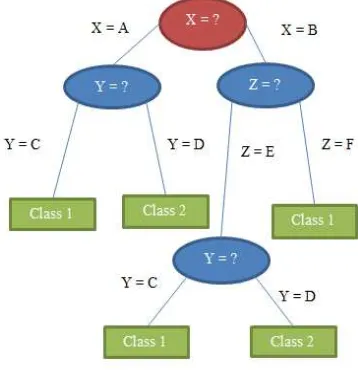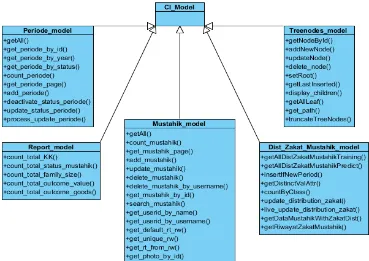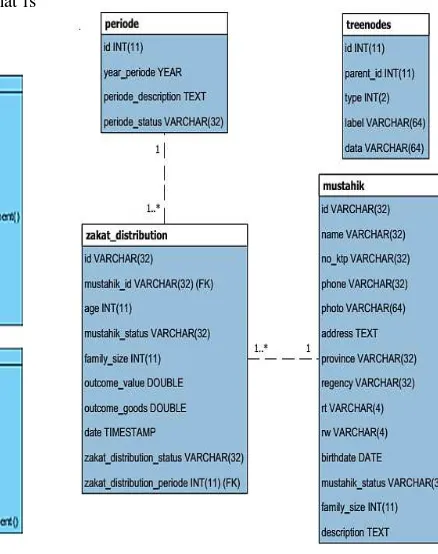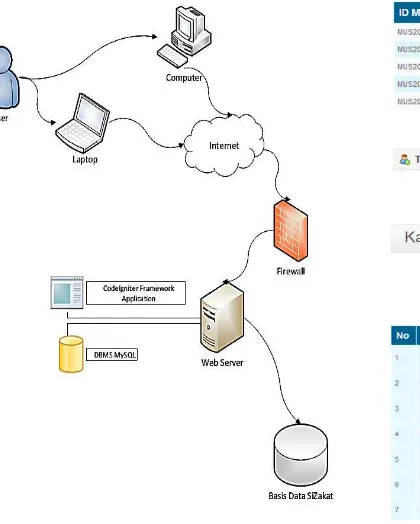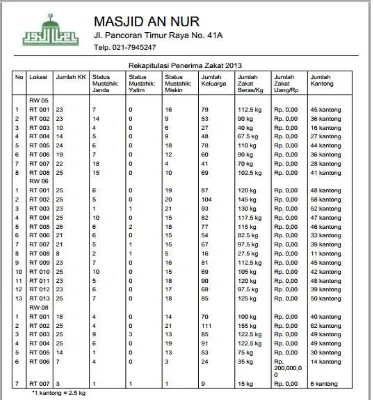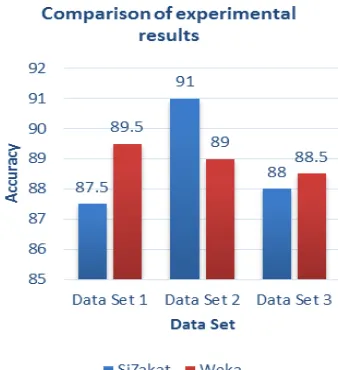30
C4.5 DECISION TREE IMPLEMENTATION IN SISTEM INFORMASI ZAKAT (SIZAKAT) TO AUTOMATICALLY DETERMINING THE AMOUNT OF ZAKAT RECEIVED BY MUSTAHIK
David Bayu Ananda and Ari Wibisono
Faculty of Computer Science, Universitas Indonesia, Kampus Baru UI Depok, Jawa Barat, 16424, Indonesia
E-mail: [email protected] Abstract
In general, Zakat Information Systems is established to manage the zakat services, so that the data can be well documented. This study proposes the existence of a feature that will determine the amount of zakat received by Mustahik automatically using C4.5 Decision Tree algorithm. This feature is expected to make the process of determining the amount of zakat be done easy and optimal. The data used in this study are the data taken from Masjid An-Nur, Pancoran, South Jakarta. The experiment results show that the proposed feature produces an accuracy rate over 85%.
Keywords: C4.5 algorithm, classification, data mining, decision tree, SiZakat
Abstrak
Pada umumnya Sistem Informasi Zakat dibangun untuk mengelola pelayanan zakat, sehingga data dapat terdokumentasi secara baik. Penelitian ini mengajukan adanya suatu fitur penentuan jumlah zakat yang akan diterima Mustahik secara otomatis dengan memanfaatkan algoritma C4.5 Decision Tree. Dengan adanya fitur tersebut diharapkan proses penentuan jumlah zakat dapat dilakukan secara mudah dan optimal. Data yang digunakan dalam penelitian ini merupakan data yang diambil dari Masjid An-Nur Pancoran Jakarta Selatan. Hasil dari eksperimen yang dilakukan menunjukkan fitur yang diajukan menghasilkan tingkat akurasi lebih dari 85%.
Kata Kunci: Algoritma C4.5, data mining, decision tree, klasifikasi, SiZakat
1. Introduction
Zakat is the third pillar of Islam that must be fulfill-ed by every Muslim in the world who are qualififulfill-ed. Zakat is divided into two types, namely: Zakat Fi-trah and Zakat Maal (wealth). Zakat FiFi-trah is an ob-ligatory zakat issued by Muslims during Eid Rama-dan. Zakat Maal is issued by Muslims associated with the property or anything that can be owned and utilized. In general, zakat is also a form of manifestation of social solidarity, binding kinship between the people and the nation, and may unify the gap between strong and weak groups.
Management of Zakat can be seen in two ma-jor processes. The first process is the process of collecting zakat paid by the payer or referred to muzakki. Muzakki can pay through mosques around him or through Unit Pelayanan Zakat (UPZ). After that, Zakat will be managed through the recording and the calculation for every mosque committee and UPZ. The second process is the process of dis-tributing zakat to the people or entities that have rights to receive zakat or commonly referred to mustahik.
There are 8 groups that are eligible to receive zakat [1]: 1) Fakir, people who do not own proper-ty and do not have adequate income to meet their needs; 2) Miskin, people who own property and de-cent income for him, but their income is not suffi-cient to meet their needs; 3) AmilZakat, people who carry out the activities of collecting zakat, ad-ministrative management, and utilization of zakat; 4) Mualaf, people who recently embrace Islam and need assistance to further strengthen their faith in Islam; 5) Hamba sahaya, slaves who want to libe-rate themselves; 6) Gharimin, people who owes money for his own good or for the community in order to implement obedience and goodness; 7) Sa-bilillah, efforts and activities of an individual or en-tity that aims to uphold the interests of the good of religion or race; 8) Ibnu Sabil, people who run out of stock or the cost of the trip which purpose is for the good of society and the religion of Islam.
family will be very difficult for the committee to complete the planning process because there are a lot of data and the number of mustahik families. In addition, in order to be fair, zakat committees should have a provision in the distribution of zakat.
We proposed implementation of C4.5 decisi-on tree algorithm to determine the amount of zakat received by Mustahik, so that the allocation of za-kat will be done automatically. We choose C4.5 de-cision tree because based on the results of prelimi-nary experiments conducted using the data mining tool Weka [2] and the results of research that has been done by several other researchers, namely Surbhi Hardikar et al. [3] and Aman Kumar Sharma et al. [4], the level of accuracy and timing modeling owned by C4.5 algorithm is better than the other algorithms and has lower error rate.
2. Methodology
Model-View-Controller (MVC) in CodeIgniter
CodeIgniter is a PHP framework that exists today. CodeIgniter is developed by Rick Ellis [5]. The purpose of the CodeIgniter framework is to pro-duce a framework that can be used in website deve-lopment so the devedeve-lopment of a website is faster than by coding manually. This framework is sup-ported by many libraries that have been provided in the CodeIgniter, so the people who develop web-site using CodeIgniter framework can focus on website development by minimizing the number of lines of code needed for various purposes of ma-king a website.
CodeIgniter apply the concept of Model-View-Controller (MVC). MVC has a goal to create dynamic websites. As the name implies, the con-cept of MVC consists of three parts, namely
Mo-del, View, and Controller. The pattern of this design has been around since 1979 when it was first des-cribed by Trygve Reenskaug from Norway [5].
Model represents data structures. All pro-cesses related to retrieval, additions, and changes to the information in the database are done on this file. View is intended to display the user informa-tion that is derived from the model. View usually consists of a full web page containing HTML. However, in CodeIgniter, a view can contain snip-pets of web pages (fragment) from the HTML. Controller is the liaison between the model and the view. Controller performs data changes to the mo-del and displays dynamic information obtained through the model into the view.
Decision Tree
Decision tree and decision rule are data mining methodology that are widely used to search for a solution within a classification problem. Decision tree method changes a very large data into a decisi-on tree model that represents the rule. A decisidecisi-on tree is a structure that can be used to divide a large data set into sets of smaller record by applying a set of decision rules [6]. A decision tree models is used to divide up a collection of heterogeneous data to homogeneous groups with smaller specific target variables [6].
Figure 1. Decision Tree Model Illustration
Algorithm: Generate_decision_tree
label that is the most class in the samples.
(6) Choose test-attribute, that has the most
GainRatio using
attribute_selection_method;
(7) give node N with test-attribute label; (8) for each ai pada test-attribute;
(9) Add branch in node N to test-attribute = ai;
(10) Make partition for sample si from
samples where test-attribute = ai; (11) if si is empty then
(12) attach leaf node with the
most class in samples; (13) else attach node that generate by
Generate_decision_tree (si,
attribute-list, test-attribute); (14) endfor
(15) return N;
Decision tree classification technique is a su-pervised learning. The class labels or categories are already defined in the beginning and in the process of making a model using the training data to clas-sify new data. Decision tree itself consists of seve-ral parts of the node [7]:
Root node, a node that is at the top of the tree, this node has no incoming branches and has more than one branch; sometimes it does not have a branch at all. This node is usually the most attributes that have the greatest influence on a particular class.
Internal node, a branching node that only has one incoming branch, and has more than one branch coming out.
Leaf node, an end node that only has one incoming branch, and has no branches at all. It also marks the node as a class label.
Figure 2.1 shows three different attributes: X, Y, and Z (oval shape). X is a root node that has the most influence in the tree. Y and Z is an internal node that has decision rule like root node. The square shape is the leaf node that shows the class label.
C4.5 Algorithm
Here are the three principles of the work done by the C4.5 algorithm according to [9] and [8]: First, perform decision tree construction. The purpose of
this decision tree construction algorithm is to create a model of a set of training data that will be used to predict the class of a new data. C4.5 algorithm is an algorithm developed by Joss Quinlan in 1993 [8]. The C4.5 algorithm is a continued develop-ment of the previous algorithm, namely the ID3 algorithm. Therefore, the actual ID3 and C4.5 algo-rithms have the same basic principles. Some deve-lopments are done on the algorithm C4.5 algorithm that makes the C4.5 different from its predecessor, that is: ability to handle attributes with discrete or continuous type; ability to handle empty attribute (missing value); can do pruning on branches; the selection is done using a calculation attribute Gain Ratio.
Second, the decision tree pruning. Since the results of decision tree construction can be bulky and not easy to "read", the C4.5 algorithm can sim-plify the decision tree with pruning based on the value of the level of confidence. Pruning also aims to reduce the prediction error rate on new data.
Third, making the rules for the decision tree that has been constructed. The rules are in if-then form that derived from the decision tree by tracing from the root node to the leaf node.
Basic algorithms used by the C4.5 algorithm for decision tree induction is a greedy algorithm that builds decision tree from top to bottom (top-down) recursively by divide and conquer [9][8]. Below is the pseudo code of the C4.5 algorithm:
Based on Algorithm 2.1, decision tree model
can be illustrated as follows. Assuming that there is one set of training data samples T that have the attributes (A1, A2, A3, ...) and classes consisting of (K1, K2, K3, ...). C4.5 algorithm will run as follows:
• If T is not empty and all the samples have the same class of Ki, then the decision tree for T is a leaf node with label Ki.
• If the attribute is empty then the decision tree contains a leaf node with label Kj where Kj is the highest class in the training samples T. • If T consists of a sample that has a different
class of the partition T into T1, T2, T3, ... Tn. Training samples T partitioned by distinct va-lues of attribute Ak, which at the time became the parent node. Suppose Ak consists of 3 ty-pes of values that are: n1, n2, n3, then T will be partitioned into three subsets, namely the value of Ak = n1, n2 = Ak, and Ak = n3. This process continues recursively with the base case of step 1 and step 2. Attribute that will serve as the parent node or attribute that will par-tition the data is done by calculating the gain. Gain is used to select the attributes to be tested based on information theory concepts of entropy.
Entropy
Entropy is a measurement based on the probability that is used to calculate the amount of uncertainty. Info (T) is also known as the entropy of T that is
explained by equation 2.1 where T is data training, Ti is subset of T that is partitioned with X attribute.
= | || | × (1)
Infox (T) is an important information to classi- fy a tuple of T that based on the partition with X [9].
Information Gain
Information gain in C4.5 algorithm is the change in entropy that occurs after partitioning the data based on an attribute. Entropy can be used to determine the purity of the data partition’s result.
= − (2)
Info (T) is the entropy of the training data before it is partitioned by attributes X, and Infox (T) is the entropy of the training data after it is partitioned by attributes X.
Gain Ratio
The calculation of the information gain still has a number of deficiencies [9].The use of information gain in ID3 algorithm focuses about testing that produces a lot of output. In other words, attributes that have lots assess are selected as attributes that
would partition the training data. Gain Ratio is added to the C4.5 algorithm to overcome the defi-ciencies in the information gain.
! ="#$ ! (3)
X is the attribute of the training data. Gain (X) is the information gain of attributes X. SplitInfo (X) is split information on attribute X that can be derived from equation 2.4.
"#$ ! = − % &''( × *+,-&|' |'( (4)
SplitInfo expresses entropy or potential infor-mation generated by partitioning training data T, into a number of different variables which are own-ed by the attribute X.
Continuous Attribute
Continuous value is handled by sorting the dis-tinct value from continuous attribute on data trai-ning T (v1, v2, …, vn) in ascending order. Threshold ! = ⌊/ 0/12
- ⌋will be calculated from i = 1 until i = n-1.
GainRatio will be applied to each threashold so that the chosen threshold is the thres-hold with biggest GainRatio.
Missing Value
GainRatio(X) will involve the probability of a known value (denoted by F). GainRatio formula (X) can be written as follows [8]:
! = 4 ×"#$ ! (5)
4 =|5 6 / $78 ||9 $ | (6)
Pruning
C4.5 algorithm uses post-pruning method. This pruning algorithm is performed from the bottom of the decision tree. Pruning is done by calculating the degree of prediction error in the subtree, another subtree that branches out from the subtree, or leaf
Figure 9. Deployment Diagram of SiZakat
Figure 6. Period Management Modules
Figure 7. Mustahik Management Modules
nodes of the subtree. If the prediction error rate of the subtree is lower, then the subtree can be replaced with a branch that comes out from the subtree or leaf nodes of the subtree.
Weka
Weka (Machine Learning Group at the University of Waikato, nd) is a data mining tool that can be used to solve data mining tasks, such as to perform classification, regression, clustering, and association rules. In this study, we use Weka to compare decision tree model and get the accuracy result of SiZakat. We use Weka as a comparison of classification models because Weka is an open source data mining tool and has many algorithms that will be used in determining the amount of zakat prediction.
3. Results and Analysis
Problem Identification
Zakat fitrah allocation per family must be planned as fair as possible by zakat committee based on the existing provisions. Moreover, zakat management process conducted by every mosque and UPZ sho-uld also be transparent and accountable. Currently most of the management of zakat is still conven-tional, i.e. by recording zakat transaction through the books one by one, then recapitalizing and re-recording for report generation, all of which are do-ne manually. This method has a high probability of wrong decision due to high amount of data.
We use data from Masjid An-Nur Pancoran, South Jakarta to develop predictive decision tree for zakat allocation to be received by each musta-hik. The data consist of 3 attributes: age, Mustahik
status, and number of family that will be classifed Class three Three bags of rice and Rp 200.000,- Class four Four bags of rice and Rp 250.000,- Class five Five bags of rice and Rp 300.000,-
System Requirement
There are two main actors in this system, Admin and Staff. Administrators manage th e Mustahik and the period. Staff has a role in Zakat calculation and recapitulation. In general, the system is built to meet the following specifications:
• The system is able to manage Mustahik • The system is able to manage period • The system is able to calculate Zakat • The system is able to make Zakat
recapitula-tion.
The other requirement is done in previous study.
System Design
The design of the system is represented in several forms as follows:
Logical View
Logical view is represented in the class diagram. Logic programming is using the concepts of Code-Igniter MVC (model-view-controller). Therefore, the class diagram is separated into Model and Con-troller Class Diagram Class Diagram.
Deployment view
Deployment view is represented in deployment di-agram.
Data view
Data view is represented in the Enhanced Entity Relationship (EER) diagram.
System Implementation
This sistem is implemented using PHP language in CodeIgniter framework. There are 4 modules that we developed after the old system: Period Manage-ment Module, Mustahik ManageManage-ment Module, Za-kat Calculation Module, and Summary Report Mo-dule.
Testing
Testing of the system is done by conducting a blackbox testing in Zakat Calculation Module. There are 570 data trains used to conduct decision tree model. The decision tree model will be tested by 3 groups of data set (200 data for each group) that are taken randomly using List Randomizer [10].
The results of this test showed that there was no significant difference between the results of data classification using Weka and C4.5 algorithms in SiZakat. Although the results of the decision tree formed by the C4.5 algorithm in Weka and SiZakat are slightly different, but the results of data classi-fication has a fairly high degree of similarity.
4. Conclusion
C4.5 decision tree algorithm is successfully imple-mented in PHP programming language and Code-Igniter framework. This implementation is a part of additional feature in SiZakat. This feature can de-termine the amount of Zakat received by Musta-hiks. In testing phase, this feature produces an ac-curacy rate over 85%. It has no significant differ-rence from Weka classifier tools.
We suggest that there should be a more com-plete data pre-processing before performing forma-tion of decision tree. So, we can ensure that the data was already completed and free from noise or out-liers to prevent over fitting.
Reference
[1] Bazis DKI Jakarta, "Petunjuk Praktis Bagi Mustahik," [Online]. Available: http://www.bazisdki.go.id/panduan/zakat12/85-petunjuk-praktis-bagi-mustahik. [Accessed 27 Mei 2013].
[2] M. Hall, E. Frank, G. Holmes, B. Pfahringer, P. Reutemann and I. H. Witten, "The WEKA Data Mining Software: An Update," SIGKDD Explo-rations, vol. Volume 11, no. Issue 1, pp. 10-18, June 2009.
[3] S. Hardikar, A. Shrivastava and V. Choudhary, "Comparison between ID3 and C4.5 in Contrast to IDS," VSRD International Journal of Compu-ter Science & Information Technology, vol. Vol. 2, no. 7, pp. 659-667, 2012.
[4] A. K. Sharma and S. Sahni, "A Comparative Study of Classification Algorithms for Spam Email Data Analysis," International Journal on Computer Science and Engineering (IJCSE), vol. Vol. 3 No. 5, pp. 1890-1895, May 2011. [5] D. Upton, CodeIgniter for Rapid PHP
Application Development, Birmingham: Packt Publishing, 2007.
[6] M. J. Berry and G. S. Linoff, Data Mining Techniques For Marketing, Sales, Customer Re-lationship Management, Second ed., Indiana-polis, Indiana: Wiley Publishing, Inc., 2004. [7] P.-N. Tan, M. Steinbach and V. Kumar,
Intro-duction to Data Mining, 1st ed., Boston: Pearson Addison-Wesley, 2006.
[8] J. R. Quinlan, C4.5: Programs for Machine Learning, USA: Morgan Kaufmann, 1993. [9] J. Han and M. Kamber, Data mining Concepts
and Techniques, Second ed., San Fransisco: Morgan Kauffman, 2006.
[10] Random.org, "RANDOM.ORG," 2012.
[Online]. Available:
